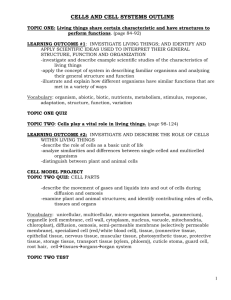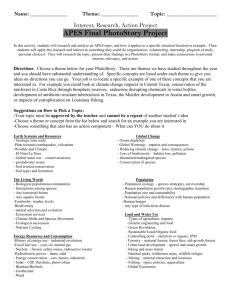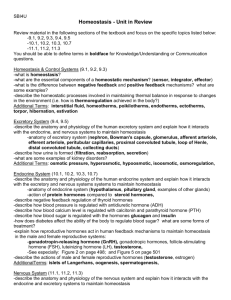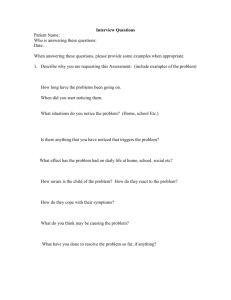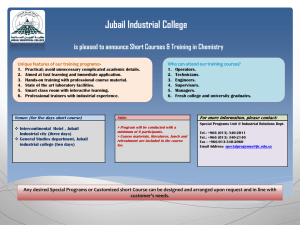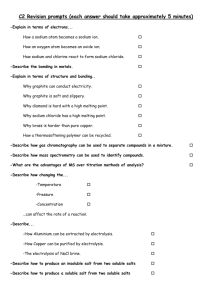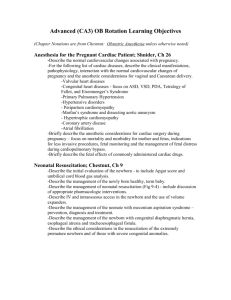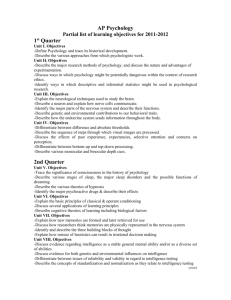S2 Science Scheme – Term 1 2005
advertisement
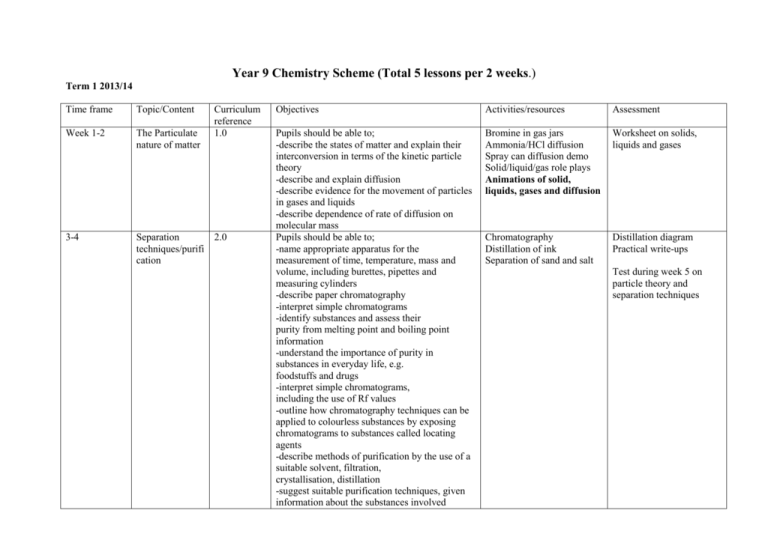
Year 9 Chemistry Scheme (Total 5 lessons per 2 weeks.) Term 1 2013/14 Time frame Topic/Content Curriculum reference 1.0 Week 1-2 The Particulate nature of matter 3-4 Separation 2.0 techniques/purifi cation Objectives Activities/resources Assessment Pupils should be able to; -describe the states of matter and explain their interconversion in terms of the kinetic particle theory -describe and explain diffusion -describe evidence for the movement of particles in gases and liquids -describe dependence of rate of diffusion on molecular mass Pupils should be able to; -name appropriate apparatus for the measurement of time, temperature, mass and volume, including burettes, pipettes and measuring cylinders -describe paper chromatography -interpret simple chromatograms -identify substances and assess their purity from melting point and boiling point information -understand the importance of purity in substances in everyday life, e.g. foodstuffs and drugs -interpret simple chromatograms, including the use of Rf values -outline how chromatography techniques can be applied to colourless substances by exposing chromatograms to substances called locating agents -describe methods of purification by the use of a suitable solvent, filtration, crystallisation, distillation -suggest suitable purification techniques, given information about the substances involved Bromine in gas jars Ammonia/HCl diffusion Spray can diffusion demo Solid/liquid/gas role plays Animations of solid, liquids, gases and diffusion Worksheet on solids, liquids and gases Chromatography Distillation of ink Separation of sand and salt Distillation diagram Practical write-ups Test during week 5 on particle theory and separation techniques 5-7 Atoms elements and compounds 3.1 8-10 Bonding 3.2 Pupils should be able to; -state the relative charges and approximate relative masses of protons, neutrons and electrons -define proton number and nucleon number -use proton number and the simple structure of atoms to explain the basis of the Periodic Table, with special reference to the elements of proton number 1 to 20 -define isotopes -state the two types of isotopes as being radioactive and non-radioactive -state one medical and one industrial use of radioactive isotopes -describe the build-up of electrons in ‘shells’ and understand the significance of the noble gas electronic structures and of valency electrons Pupils should be able to; -describe the differences between elements, mixtures and compounds, and between metals and non-metals -describe an alloy, such as brass, as a mixture of a metal with other elements -describe the formation of ions by electron loss or gain -describe the formation of ionic bonds between elements from Groups I and VII -describe the formation of single covalent bonds in H2, Cl2, H2O, CH4 and HCl as the sharing of pairs of electrons leading to the noble gas configuration -describe the differences in volatility, solubility and electrical conductivity between ionic and covalent compounds -describe the formation of ionic bonds Duplo model of particles (type in a question about particles into): http://www.bbc.co.uk/gcsebi tesize Radioactive isotopes http://www.cancerhelp.org.u k/ http://www.bnfl.com/ Electron configuration tables ‘Fun with rulers’ ionic and covalent bonding role plays Test during week 10 on atomic structure and bonding Notes on covalent bonding in some of these molecules: http://www.rjclarkson.dem on.co.uk/middle/bindinstru ct..htm#covalent http://mineral.galleries.co m/minerals/silicate/quartz. htm between metallic and non-metallic elements -describe the lattice structure of ionic compounds as a regular arrangement of alternating positive and negative ions -describe the giant covalent structures of graphite and diamond -relate their structures to the use of graphite as a lubricant and of diamond in cutting -describe the electron arrangement in more complex covalent molecules such as N2, C2H4, CH3OH and CO2 -describe the macromolecular structure of silicon(IV) oxide (silicon dioxide) -describe the similarity in properties between diamond and silicon(IV) oxide, related to their structures -describe metallic bonding as a lattice of positive ions in a ‘sea of electrons’ and use this to describe the electrical conductivity and malleability of metals 11-14 Energy Changes 6.0 Pupils should be able to; -describe the meaning of exothermic and endothermic reactions -describe bond breaking as endothermic and bond forming as exothermic -describe the production of heat energy by burning fuels -describe hydrogen as a fuel -describe radioactive isotopes, such as 235 U, as a source of energy Circus of Exothermic/endothermic reactions Energy in fuels investigation Data logging Practical write-ups Energy calculations Year 9 Chemistry Scheme (Total 5 lessons per 2 week.) Term 2 2013/14 Time frame 1- 4 Topic/Content Rate of reaction Curriculum reference 7.1 Objectives Activities/resources Assessment Pupils should be able to; -describe the effect of concentration, particle size, catalysts (including enzymes) and temperature on the speeds of reactions -describe a practical method for investigating the speed of a reaction involving gas evolution -describe the application of the above factors to the danger of explosive combustion with fine powders (e.g. flour mills) and gases (e.g. mines) -devise a suitable method for investigating the effect of a given variable on the speed of a reaction -interpret data obtained from experiments concerned with speed of reaction -describe and explain the effects of temperature and concentration in terms of collisions between reacting particles -describe the effect of light on the speed of reactions -describe the use of silver salts in photography as a process of reduction of silver ions to silver; and photosynthesis as the reaction between carbon dioxide and water in the presence of chlorophyll and sunlight (energy) to produce glucose Calcium carbonate marble chips in terms of concentration/temperat ure/surface area investigation and/or sodium thiosulphate investigations Practical write-ups Hydrogen peroxide and catalyst practical Simple rate practicals Full investigation of the effect of surface area HCl marble chips Demo effect of light on silver compounds Test during week 5 on Energy Changes and Rate of reaction 5- 7 8-10 Reversible reactions and Chemical equilibrium Redox 7.2 12.1 Part of 11 7.3 Pupils should be able to; -describe the idea that some chemical reactions can be reversed by changing the reaction conditions -predict the effect of changing the conditions (temperature and pressure) on other reversible reactions -concept of equilibrium -name some sources of sulfur -name the use of sulfur in the manufacture of sulfuric acid -name the uses of sulfur dioxide as a bleach in the manufacture of wood pulp for paper; as a food preservative (by killing bacteria) -describe the manufacture of sulfuric acid by the Contact process, including essential conditions -describe the essential conditions for the manufacture of ammonia by the Haber process including the sources of the hydrogen and nitrogen, i.e. hydrocarbons or steam and air -describe the need for nitrogen-, phosphorus- and potassium-containing fertilisers Pupils should be able to; -define oxidation and reduction in terms of oxygen loss/gain. -define redox in terms of electron transfer -identify redox reactions by changes in oxidation state and by the colour changes involved when using acidified potassium manganate(VII), and potassium iodide. Demo Copper sulphate as an example of a reversible reaction. RSC video on the Haber Process and sulphuric acid. Questions from Chapter 11 Chemistry for IGCSE Haber process Question Sheet. http://gbs.glenbrook.k 12.il.us/Academics/gbs sci/chem/Chem163/pr ojects/factory/factory. htm Harber process http://www.cem.msu.edu/ ~parrill/equilibria www.efma.org/publicatio ns/index.asp Notes on sulphur: http://www.rjclarkson.de mon.co.uk/middle/middle 2.htm KMnO4 colour demo Reduction of Copper oxide http://www.drydenaqua .com/ Ionic equations practice questions Week 1114 Electricity and Chemistry 5.0 Pupils should be able to; -describe the electrode products in the electrolysis of: molten lead(II) bromide concentrated hydrochloric acid concentrated aqueous sodium chloride between inert electrodes -state the general principle that metals or hydrogen are formed at the negative electrode, and that non-metals are formed at the positive electrode -predict the products of the electrolysis of a specified binary compound in the molten state -describe the electroplating of metals -name the uses of electroplating -describe the reasons for the use of copper and (steel-cored) aluminium in cables, and why plastics and ceramics are used as insulators -relate the products of electrolysis to the electrolyte and electrodes used, exemplified by the specific examples in the Core together with aqueous copper(II) sulfate using carbon electrodes and using copper electrodes -name the uses of copper related to its properties (electrical wiring and in cooking utensils -describe electrolysis in terms of the ions present and reactions at the electrodes in the examples given -predict the products of electrolysis of a specified halide in dilute or concentrated aqueous solution -describe, in outline, the manufacture of (i) aluminium from pure aluminium oxide in molten cryolite Aluminum extraction video Electrolysis of brine video Electrolysis of Lead Bromide Electrolysis of HCl/NaCl/CuSO4 Electroplating Purification of Copper Aid to electroplating (mainly lists of materials) http://www.finishing.com/ Electrolysis Questions Test in week 14 – Redox, electrolysis and equilibrium -name the main ore of aluminium as bauxite -name the uses of aluminium: in the manufacture of aircraft because of its strength and low density; in food containers because of its resistance to corrosion (ii) chlorine and sodium hydroxide from concentrated aqueous sodium chloride Year 9 Chemistry Scheme (Total 5 lessons per 2 week.) Term 3 2013/14 Time frame 1-4 Topic/Content Stoichiometry Curriculum reference 4.0 Objectives Activities/resources Assessment Pupils should be able to; -use the symbols of the elements and write the formulae of simple compounds -deduce the formula of a simple compound from the relative numbers of atoms present -deduce the formula of a simple compound from a model or a diagrammatic representation -construct word equations and simple balanced chemical equations -define relative atomic mass, Ar -determine the formula of an ionic compound from the charges on the ions present -construct equations with state symbols, including ionic equations Empirical formula using hydrated copper sulphate and burning magnesium or copper oxide Notes on formula writing: http://www.rjclarkson.demon.co.uk/junior/ Empirical formula questions Molarity calculations Calculations from equations Other relevant calculations http://www.liv.ac.uk/chemistry/links/constants.html Hints for basic amount calculations: http://science.widener.edu/svb/pset/stoichio.html Worked examples see in: http://www.rjclarkson.demon.co.uk/ 5-7 Stoichiometry (continued) 4.0 The Periodic Table 9.0 -deduce the balanced equation for a chemical reaction, given relevant information -define relative molecular mass, Mr, as the sum of the relative atomic masses Pupils should be able to; -define the mole and the Avogadro constant -use the molar gas volume, taken as 24 dm3 at room temperature and pressure -calculate stoichiometric reacting masses and volumes of gases and solutions -calculate empirical formulae and molecular formulae -calculate % yield and % purity Pupils should be able to; Describe the Periodic Table as a method of classifying elements and its use to predict properties of elements -describe the change from metallic to nonmetallic character across a period Test during week 5 on Stoichiometry Demo alkali metals in water Video on alkali metals Investigate the appearance of transition metals http://www.cs.ubc.ca/cgi-bin/nph-pertab/tab/periodic-table http://www.webelements.com/ http://chemlab.pc.maricopa.edu/periodic/periodic.html -describe lithium, sodium and potassium in Group I as a collection of relatively soft metals showing a trend in melting point, density and reaction with water -predict the properties of other elements in Group I, given data, where appropriate -describe chlorine, bromine and iodine in Group VII as a collection of diatomic nonmetals showing a trend in colour, state and their reaction with other halide ions -predict the properties of other elements in Group VII, given data, where appropriate -describe the transition elements as a collection of metals having high densities, high melting points and forming coloured compounds, and which, as elements and compounds, often act as catalysts -describe the noble gases as being unreactive -describe the uses of the http://www.dayah.com/periodic/ http://www.chemicool.com/ http://www.chemsoc.org/viselements/ Periodic table teaching site: http://www.genesismission.org/educate/scimodule http://edis.ifas.ufl.edu/scripts/htmlgen.exe?DOCUMENT_AE080 http://c3.org/ noble gases in providing an inert atmosphere, i.e. argon in lamps; helium for filling balloons -describe the relationship between Group number, number of valency electrons and metallic/nonmetallic character -identify trends in other Groups given information about the elements concerned 8-9 End Of Year Exams Go over EOY exam using mark schemes given
